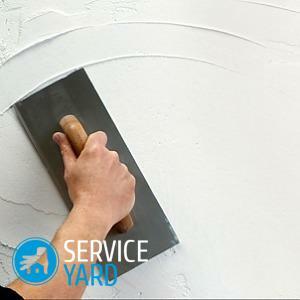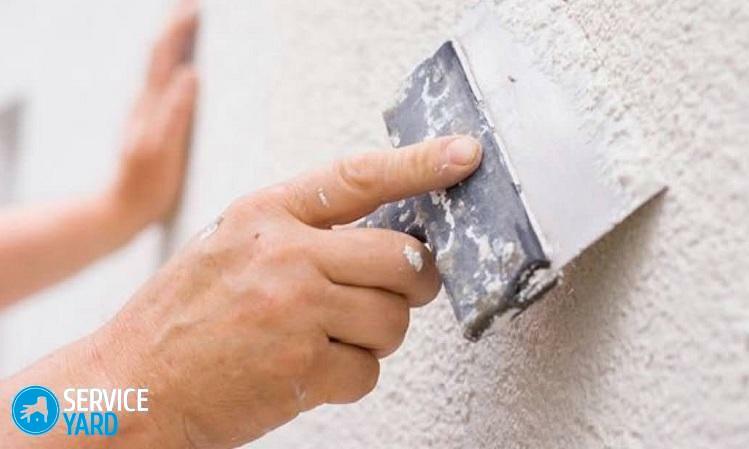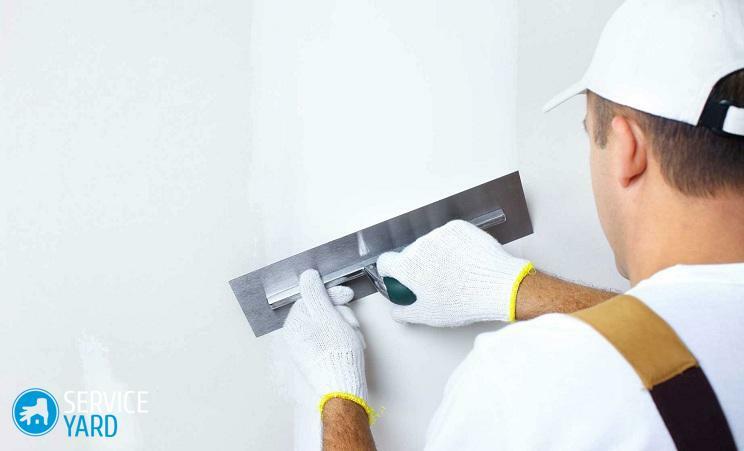
- Kinds of putty mixes
- The main types of putty mixes for the intended use:
- Kinds of putty filler
- How not to make a mistake in the choice?
- We choose the filler for the walls for the wallpaper
- Putty the walls for the wallpaper
- Rating of the best manufacturers of building mixtures
Before you carry out the finishing decoration of the walls, they must be aligned. Elimination of defects on the walls and leveling is done with a putty. To date, on the market of building materials are putty mixes that have different compositions, purpose and functional direction. In this regard, sometimes even the most experienced masters are confused in the choice. In order to correctly determine which shpaklevka better for walls under the wallpaper, we offer a more detailed consideration of all options and varieties of this material.
to the contents ↑Kinds of putty mixes
To ensure that the puttying process does not cause problems and the putty is laid smoothly and smoothly, you should choose it correctly. All of them are classified according to the following characteristics:
- Purpose and form of release.
- Type of substance in the base.
The main types of putty mixes according to their intended use:
- Starting putty. It is designed for plastering walls with strong flaws. It can also be applied to concrete or brick walls. This kind of putty mixes is applied in several layers( if necessary), a thickness of about 10 millimeters each.
Important! To improve the adhesion of the starting putty when applied in several layers, use reinforcing mesh.
- Finishing putty. I use it already after the walls have been worked out starting and all the layers have completely dried. From the starting mixture the finish line is distinguished by its fine grain. Due to this, the layers are applied in a thin layer, a thickness of about 3-4 millimeters.
Important! According to the rules, it is best to use these two kinds of mixtures together. Starting - you remove the defects of the walls, and the finish - bring the result to the full condition. Starting and finishing putties can be designed for both indoor and outdoor work. When buying, pay attention to this, since they have different levels of adhesion and moisture resistance.
- Universal. By their qualities can perform the functions of both starting and finishing putty.
Important! Putties are still divided into dry and ready mixes:
- Dry mixes are the most profitable and in demand among consumers. Their advantage is that you yourself can prepare the required amount of a mixture of the desired consistency.
- Ready mixes often need to be produced immediately after opening, unlike dry ones.
In order to know what kind of putty is best for walls for wallpaper, it is important to take into account the composition of this material and its adhesive properties.
to the contents ↑Kinds of fillers according to the composition
The composition of any construction mixture is the main criterion in choosing. In this case, in order to understand which shpaklevka better for walls for wallpaper, you need to understand the difference between each of the options on the market.
Cement
This mixture can be called the most versatile. It is used both for internal works and for external ones. It is best to use a cement putty mixture with decorative putty or tile. These materials, due to their rigidity, easily hide the rough texture of the cement putty.
Advantages of cement putty:
- high strength;
- resistance to moisture.
Important! The main disadvantage is the poor workability of this material. It is very hard to sweep. Therefore, in practice, the cement filler is used as a "rough coat" to prepare the walls before the decorative finish.
Gypsum
This kind of putty mixes is used exclusively for interior work. This is because the gypsum is destroyed by the action of moisture. Therefore, it is not suitable for outdoor work.
The gypsum mixes on the setting time are divided into the following groups:
- rapid setting( 50-60 minutes);
- normal setting( 60-180 minutes);
- slow setting( more than 180 minutes).
 Advantages of gypsum putty mixes:
Advantages of gypsum putty mixes:
- have high adhesion;
- after drying is characterized by no shrinkage;
- security;
- fire resistance;
- hypoallergenicity;
- is a small expense.
Important! The main disadvantage is the high sensitivity to humidity.
Acrylic or "jewelery"
It is applied to a finished and flat wall with a layer of not more than 1 millimeter. It is used to prepare walls before painting. If you did everything correctly, then after applying this kind of putty mix the walls will get a glossy coating.
It is suitable for both interior and facade work. Acrylic putty mixtures are classified as "premium".
Important! The main disadvantage is a rather high price.
to the contents ↑How not to make a mistake in the choice?
Even having studied all the information about putty and its varieties, you can still make a mistake in choosing. That this does not happen, it should always be borne in mind that the most important selection criterion is the goal for which you need this material. The rules below will be useful to you so that you can get a good quality putty mixture:
- If you can not determine the purpose of the putty mixture, it is better to choose the universal types.
- To avoid forgery and poor quality, carefully study the mixture for unnatural inclusions.
- To save budget, choose dry mixes.
- Do not forget to check the color of the putty material. If you decorate the room with light colors, then the mixture should be white.
We choose the putty for the walls for the wallpaper
In order to determine which putty putty the walls under the wallpaper, you should always take into account the condition of the walls, because how convenient and aesthetically to do the wallpapering on a perfectly flat surface. Accordingly - you will need to choose the filler as starting and finishing.
Surface of walls with defects
At the initial stage start mixtures are used, and then - finish. It is very important, when choosing a putty mixture to take into account the humidity level of the room - this also affects the adhesive properties of the putty. Therefore, you should always pay attention to the marking, which is indicated on the packaging of this building material:
- For premises with high humidity, it is necessary to take a filler, which will have the mark "LR" on the package.
- Marking "KR" means that this putty is intended exclusively for dry rooms.
Important! As practice shows, gypsum putty mixes are best suited for fitting walls before wallpapering. For the finish coat, you can take acrylic putty mixes.
Smooth surface of walls
If the walls are smooth enough, without flaws, then you can go directly to the finish putty. In order to determine which finish putty is best, you need to know the requirements that qualitative material meets:
- High adhesive properties.
- The seller has a certificate.
- Not expired.
If you have chosen a quality putty mix, then it will have such qualities:
- is well applied to the starting base;
- no lumps and easy movement behind the spatula;
- should not drain on walls;
- finishing putty can clean small wall defects;
- no cracks after drying.
Finishing putty must fully cope with the tasks assigned to it. It must be of high quality, functional, easy to apply. Practitioners recommend a polymer finish. Despite its high cost, it creates a perfectly even coating on which you can make wallpaper wallpapering.
Important! Try to purchase building materials only in specialized stores. Thus, you will save yourself from forgery or poor-quality goods.

We choose the filler for drywall under wallpaper
Putty the wall of gypsum board before gluing the wallpaper is necessary:
- If you glue the light wallpaper, then thanks to the putty the wall will not be transparent.
- When you change wallpaper, puttying will make it easier for you to remove them.
In order to know how to choose a filler for walls for wallpapers, we offer you a few tips that will make it easier for you:
- If you do not have the practice of puttying, then it's better to get ready-made mixes. They cost an order of magnitude more expensive, but they will not be difficult to apply.
- Facade putties are unsafe for health, therefore they are not categorically suitable for interior work.
- Drywall walls themselves are quite even. They do not require a large amount of putty material. Therefore, it is better to get quality mixes.
- Try to choose a putty mixture from a manufacturer with a good reputation.
Important! Joints of plasterboard are subject to mandatory plastering.
Before plastering, the gypsum board is primed. A gypsum board wall does not require a starting putty, so you can do just the finish.
to the contents ↑Wall plastering under the wallpaper
Wall plastering can be carried out by hand, even if you are new to this business. The main thing is to follow the algorithm, adhere to the temperature regime and the correct inventory.
What do you need when plastering?
- wide and narrow spatula;
- starting and finishing putty mixes;
- grinding bar - please note that it has an abrasive mesh;
- dilution container if the putty is dry;
- foam sponge;
- drill;
- platen for primer;
- trowel or sandpaper;
- level.
Preparation of
solution If you have purchased a ready mix, then you can apply it on the walls immediately. Dry mixtures should be diluted.
For this:
- You need to pour a small amount of water into the bucket( or other container).
Important! Before filling the filler, make sure that the walls of the bucket are wet.
- Next, fill up the filler and mix it with a drill.
- The consistency of the mortar can be adjusted by adding more water or putty.
Important! In order for the putty mixture to turn out to be of high quality, it is necessary to adhere to certain nuances during kneading.
- In order to avoid bubbles on the finished surface, do kneading with a drill at a low speed.
- Use only clean water at room temperature. Excessively cold or hot water will promote rapid peeling of the putty.
- The putty freezes for 40 minutes. Always keep this in mind before selecting the amount of batch material.
- Always study the recommendations that the manufacturer indicates on the package.
Preparing the wall for wallpapering
After you have decided what better to putty the wall under the wallpaper, prepared a putty solution, you can go directly to work:
- Prepare the surface. It must be cleaned, dried and degreased.
- Priming. Some miss this stage. But priming provides additional strength between layers.
- Application of putty. Depending on the purpose of the room and the quality of the walls, we apply the required number of layers of the starting mixture.
Important! Do not start working until the previous layer has dried.
- Each layer after drying is treated with a primer. The starting putty is applied with a large spatula. It is applied portionwise, diagonally. To reduce the visibility of the transitions, each portion is laid out with a small influx to the previous layer.
- Finish we apply not earlier, than in day after drying of a starting mixture. It is applied with a spatula of a smaller size, a thin layer.
- Final primer. We produce it before the very wallpapering.
Rating of the best manufacturers of building mixtures
So that you do not doubt that you have chosen the best shpaklevku for repair in your own home, when choosing the material, consider the feedback of professional masters and beginners. All of them have already made sure that the following manufacturers offer the best construction mixtures:
- Knauf HP( starting).This putty mix is very popular. It is designed to work in residential and non-residential premises, with normal air humidity. The minimum thickness of the layer is 4 millimeters, the maximum is 5. It is produced in bags weighing 30 kilograms. This putty mixture has proved to be very good. When used, no shortcomings were found.
- Knauf HP( final).Perfectly prepares the walls for painting or wallpapering. Suitable for rooms with low and normal humidity. The thickness of the layer should not exceed 4 millimeters. The prepared mixture is suitable for use only 15 minutes. The main drawback is that large particles enter the mixture, which can complicate the work.
- Kreisel 662( universal).This is a fine-grained cement putty. It is designed to be applied to both prepared and concrete walls. It is applied with an exceptionally thin layer. Suitable for both interior and facade work. Not afraid of high humidity. Sold in bags of 25 kilograms. The only drawback is that it shrinks.
- Ceresit ST 29( starting).This putty has a gypsum base. Suitable for work both inside and outside the room. It is also used to cover various defects. Do not use in damp areas. The composition contains microfibers, which provide a strong grasp. Sold in bags of 25 kilograms. Its only drawback - high cost in relation to others.
- Ceresit CT 225( finishing).It also has a gypsum base. It should be applied to a dry primed surface, after the starting layer of putty. Just like the starting one, it is produced in a package weighing 25 kilograms. The disadvantage is the high price.
Puttying walls, though difficult process, but it can always be learned. The most important thing is to remember all the rules and stages of preparing the surface for applying a decorative finish. But if you have taken everything into account, then you can safely get down to work, because despite the laboriousness of the process, it is quite fascinating. And most importantly - making the puttying of the walls with your own hands, you not only gain experience, but also significantly save the family budget.

